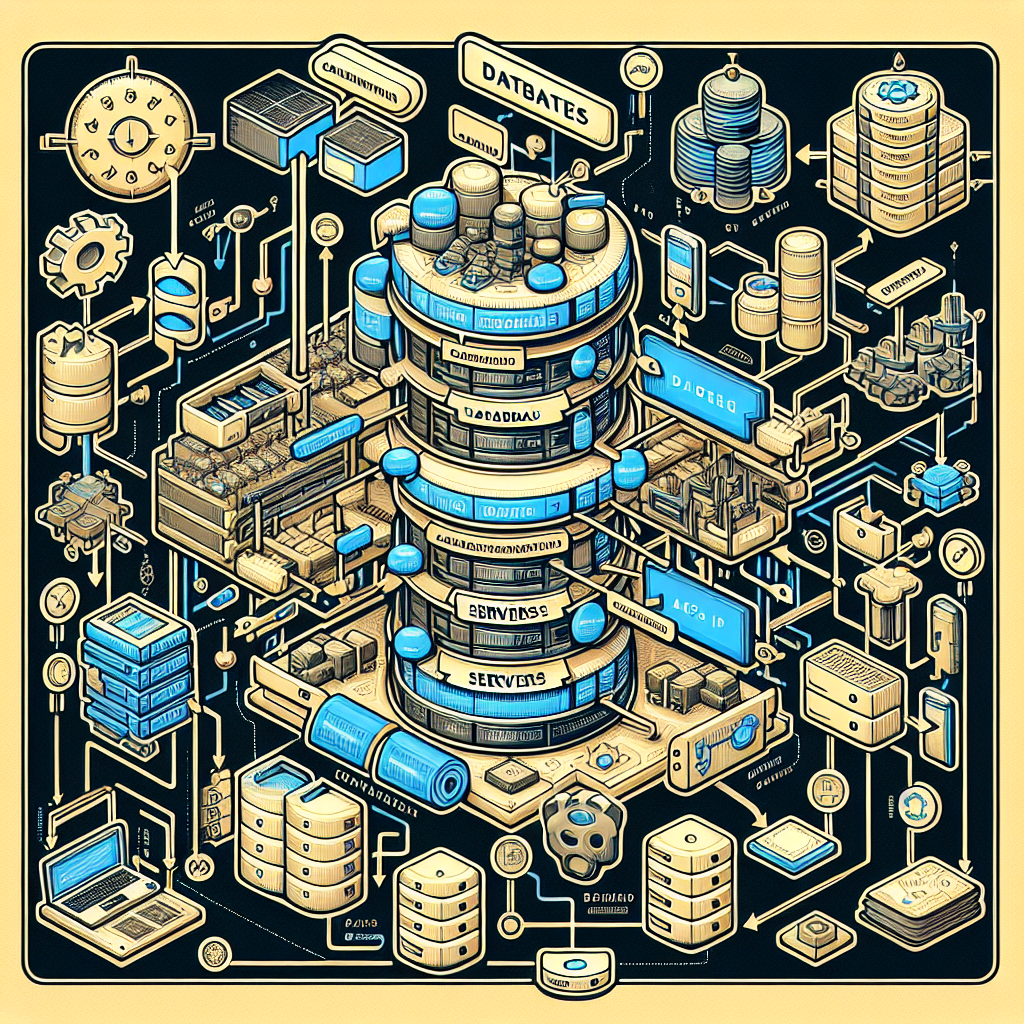Delivering Exceptional Backend Development Solutions for All Applications
What is the Backend of an Application and Why It Matters for Your Business?

Have you ever wondered how your favorite applications manage to run so smoothly behind the scenes? ⭐ The answer often lies in a concept known as backend development. But what exactly is the backend of an application? This term refers to all the behind-the-scenes activities that allow an application to function. It encompasses servers, databases, APIs, and everything in between. Without a properly functioning backend, any application—be it an online store or a project management tool—would simply crumble. For business owners, understanding this aspect of software is crucial for achieving growth and efficiency.
Why does it matter for your business? Well, consider this: according to recent statistics, a seamless user experience can boost customer retention rates by up to 50%. ⭐ Not only does this mean happier customers, but it also translates to higher profits. In a world where competition is fierce, ensuring your applications backend is solid can be the difference between thriving and just surviving.
Why Should You Care About Backend Development?
Here are a few key reasons why backend development is essential for your business:
- Performance Efficiency: A robust backend allows applications to handle multiple requests simultaneously without crashing. Think of an e-commerce site during Black Friday sales; a reliable backend keeps the site from going down when traffic spikes! ⭐
- Data Management: The backend is responsible for storing and managing your application data. For example, if you run a fitness tracker app, the backend stores users’ data, workout history, and preferences securely.
- Security: Strong backend development includes secure user authentication and data encryption. Imagine a scenario where you’ve built an application that handles sensitive data; without a secure backend, you risk compromising your users information. ⭐
What is Included in Backend Development?
Backend development includes various components, such as:
- Server: The powerhouse of your application where all requests are processed.
- Database: Where your application data is stored, organized, and managed.
- APIs (Application Programming Interfaces): These act as bridges, allowing different applications to communicate.
- Business Logic: The rules and logic that dictate how data can be created, stored, and changed.
- Integration with Third-Party Services: For example, connecting your app to a payment processing system.
Real Stories: How the Backend Saves the Day
Let’s look at a real-world scenario: a client approached us, frustrated because their online store was crashing during peak shopping times. This instability was not only costing them revenue but also damaging their reputation. Our team at Zuniweb Studio quickly analyzed their backend structure and discovered it was not equipped to handle the volume of transactions.
We reworked their backend, implementing load balancing and optimizing their database. ⭐ Once the new backend was in place, their site saw a 70% decrease in downtime during peak hours. This not only boosted sales but also enhanced customer satisfaction. Imagine the relief when your users can shop without interruptions!
Scenarios Where Proper Backend Matters
Picture this: you have an app that helps users track their health and fitness goals. Suddenly, one of your key functionalities fails because of an unoptimized backend. Users start complaining, and your ratings plummet. ⭐ A well-crafted backend structure would prevent this kind of disaster, ensuring your application runs smoothly, even under stress.
Another case might involve a simple blog. You want to add a comment section to increase engagement. However, if the backend isnt adequately set up to handle the database demands, you risk malfunctioning features that can frustrate users.
The Future: Do All Applications Have a Backend?
Curious whether all apps have a backend? While many do, the rise of serverless architectures is changing the landscape. These applications allow developers to focus more on the frontend while removing concern for the backend infrastructure. However, having a strong backend still offers advantages, especially for applications that require heavy data processing.
If you’re thinking, “I need this for my business!” you’re spot on. Creating a backend for an application is not just an option nowadays—it’s a necessity. And here at Zuniweb Studio, with over 20 years of experience, our team of professional specialists can help you craft a backend solution tailored to your needs. Why juggle multiple vendors when you can find everything in one place with us?
Get in touch today! ⭐ You can call Alexandr at Go Telegram Chat or visit our website zuniweb.com to learn more about how we can help your business thrive through exceptional backend development. Lets build something great together!
Frequently Asked Questions
- What is the backend of an application?
The backend refers to the server-side of an application where business logic, database interactions, and server configurations occur. - What is considered backend?
Backend involves servers, databases, and APIs that process data and manage application functions behind the scenes. - What is the purpose of the backend?
The backends core purpose is to manage application data, process requests, and ensure the smooth operation of user-facing features. - What is included in backend development?
Backend development includes building the server, database, API, and overall application architecture. - Do all applications have a backend?
No, not all applications do, especially with the advent of serverless models, but most traditional apps require a backend. - Can I create a backend for my existing application?
Absolutely! Our team specializes in creating and optimizing backends for various applications. - How long does backend development take?
It depends on the complexity of the application, but most projects take anywhere from a few weeks to several months. - What technologies are used in backend development?
Common technologies include Node.js, Python, Ruby, Java, and various database systems like MySQL or MongoDB. - How secure is my backend?
We implement robust security measures, including encryption and secure authentication methods, to protect your data. - What if I need ongoing support for my backend?
We offer various support packages tailored to your specific needs to ensure your application runs smoothly over time.
What is Considered Backend? Demystifying Roles and Responsibilities in Application Development
contact us
Game apps can be really expensive to build and maintain, but don’t worry, we do everything in our mix to ensure that you get the best, for the best cost.

In the realm of application development, understanding what is considered backend is crucial for anyone looking to create robust software. ⭐ So, what exactly does the term "backend" encapsulate? Think of it as the hidden engine that powers your favorite applications. Just like an iceberg, where only a small portion is visible above water, the backend is what operates below the surface, handling data storage, user management, and overall security.
Let’s break it down! The backend comprises various components that work together to create a seamless experience for the end-user. Heres a closer look at what’s really included:
- Server: This is the computer or a set of systems that processes requests, runs the application, and sends responses back to the client (the frontend). Imagine it as the brain of your application, interpreting and executing commands. ⭐
- Database: Your application stores vast amounts of data in a database. Be it user profiles, transactions, or inventories, you can think of it as a library that efficiently organizes and retrieves information when needed. ⭐
- APIs (Application Programming Interfaces): These allow different software applications to communicate with one another. APIs can be seen as messengers that carry requests from the frontend to the backend and vice versa. For example, when you log into an app using Facebook, an API handles that connection.
- Business Logic: This encompasses the rules and calculations dictating how data can be created, stored, or modified within the application. Think of it as the operating manual that ensures your app behaves the way you intended.
- Middleware: This is the software that connects different applications or services, facilitating communication between the server and the database. It acts like a translator, helping different systems speak the same language.
Roles and Responsibilities in Backend Development
Now that we’ve defined what is considered backend, let’s demystify the various roles involved in backend development. Understanding these responsibilities helps you appreciate the expertise that goes into crafting a successful application. Here are some of the key players:
- Backend Developers: These are the architects of the backend. They write the code that dictates how the server, database, and app interact. With languages like Python, Java, Ruby, and PHP, backend developers ensure that all the components work seamlessly together. ⭐
- Database Administrators: Responsible for maintaining the database, these professionals ensure data integrity, performance tuning, and backup protocols are all in place. Think of them as librarians, ensuring all books (data) are well-organized and readily accessible.
- DevOps Engineers: The bridge between development and operations, DevOps engineers focus on infrastructure management, deployment processes, and server maintenance. They work to automate processes, ensuring that any new updates or features roll out smoothly and efficiently.
- System Architects: These individuals design the overall structure of the application’s backend. They make high-level decisions regarding technology stacks, frameworks, and tools that will be used in the development process.
- Quality Assurance (QA) Engineers: Once the backend is built, QA engineers test it to ensure everything functions as intended. They look for bugs, performance issues, and security vulnerabilities—essentially, they’re the safety net for your application. ⭐️
Real-World Example: A Clients Journey
Let’s dive into a compelling story to illustrate these roles in action. A local restaurant wanted to build an online ordering system. They approached us at Zuniweb Studio, recognizing they needed a solid backend to support their new venture. We began by assigning a dedicated team. The backend developers crafted the server logic and database schema, while the database administrators kept track of menu items and user orders. ⭐
Meanwhile, our DevOps engineer implemented a continuous integration/continuous deployment (CI/CD) pipeline to instantly push updates. As the QA engineers tested every feature—ensuring customer details were securely stored and transactions were processed correctly—the system architect designed a scalable infrastructure that could handle surges during busy meal times. Within weeks, the restaurant was up and running with minimal hiccups, satisfying hungry customers almost immediately! ⭐️
Why Understanding Backend Matters
So, why does it matter to grasp what is considered backend and the roles involved? In today’s digital age, the backend serves as the backbone of any application. Businesses across all sectors rely on efficient backend systems to ensure smooth operations, maintain security, and provide an excellent user experience. Every time you book a flight, shop online, or chat with a friend, it’s the backend that works tirelessly behind the scenes, making things happen. You can trust that investing in quality backend development can significantly affect your business’s success. ⭐
If youre ready to elevate your application and need professional assistance, dont hesitate to reach out to us at Zuniweb Studio. Our professional specialists, with 20 years of experience, can tailor a backend solution that suits your needs. Call us today at Go Telegram Chat or visit zuniweb.com to get started!
What is the Purpose of the Backend? Understanding Its Core Functionality in Modern Applications
contact us
Game apps can be really expensive to build and maintain, but don’t worry, we do everything in our mix to ensure that you get the best, for the best cost.

When we talk about the purpose of the backend in modern applications, we’re diving into the very heart of what makes software run smoothly and efficiently. ⭐ But what does this mean for you as a business owner or an aspiring developer? Lets break it down in clear terms.
Crucial Functions of the Backend
The backend serves as the invisible engine that powers applications, ensuring they function properly and deliver a seamless user experience. Here are the core functionalities:
- Data Management: One of the primary purposes of the backend is to manage data—storing, retrieving, and modifying it when necessary. Whether it’s user profiles, transaction histories, or product inventories, the backend ensures this information is organized and accessible. Consider an online bookstore; it relies heavily on its backend to manage book titles, prices, and customer orders. ⭐
- User Authentication: Security is paramount in today’s digital landscape. The backend handles user authentication and authorization processes, making sure that only verified users can access specific resources. For instance, when you log into a banking app, the backend verifies your identity and ensures your sensitive information remains protected. ⭐
- Business Logic Implementation: The backend executes the rules that dictate how data should interact. If you imagine your application as a grand theater production, the backend contains the script (business logic) that directs all the actions happening on stage (the frontend). This logic ensures that, for example, when a user adds an item to their shopping cart, the inventory is updated in real-time.
- API Development: APIs act as a bridge between different software components. The backend exposes APIs that allow the frontend to communicate efficiently with the server, ensuring that users can interact with the application without any hiccups. Think of APIs like the waitstaff at a restaurant—they take orders from customers (frontend) and relay them to the kitchen (backend). ⭐️
- Performance Optimization: The backend is responsible for ensuring that applications can handle multiple requests simultaneously, allowing for quick responses even during high traffic periods. Imagine running a successful online event; the backend must support numerous registrations smoothly without crashing. ⭐
Understanding How These Functions Benefit Your Business
The purpose of having a well-structured backend goes beyond mere functionality—it directly impacts your business revenue and reputation:
- Enhanced User Experience: A stable and efficient backend leads to a smooth user experience, encouraging users to return. If customers have an enjoyable shopping experience on your e-commerce site, they’re more likely to make repeat purchases.
- Data-Driven Insights: A strong backend allows you to collect and analyze data effectively. This means you can gain insights into customer behavior, helping you make informed business decisions. For example, letting data dictate your marketing strategy can lead to more targeted ad campaigns, ultimately increasing conversion rates.
- Improved Security: Security breaches can be disastrous for businesses. An effectively implemented backend structure secures sensitive data against unauthorized access, safeguarding your company’s reputation. Damage control after a data breach can be far costlier than investing in robust backend security measures.
- Scalability: As your business grows, your application needs to evolve too. With a strong backend, scaling becomes easier, enabling your application to handle increased volumes of data and user requests without a hitch.
Real-World Example: A Startups Success Story
Consider a startup that offers meal prep services. Initially, their backend was rudimentary, struggling during high-demand periods, resulting in slow load times and frustrated customers. They decided to partner with Zuniweb Studio to revamp their backend. Our professional developers assessed their pain points and implemented a new backend infrastructure that emphasized data management and performance optimization.
As a result, when the next peak season arrived, the application effortlessly handled increased traffic. Customers could browse menus, customize orders, and checkout in record time. Not only did this enhance user experience, but it also led to a significant increase in customer retention rates, ultimately doubling their sales within a few months! ⭐
Make the Most of Your Backend
Understanding the purpose of the backend and its core functionality can make a significant difference in your business operations. By focusing on creating a quality backend, you can ensure data integrity, a smooth user experience, and enhanced overall performance.
If youre ready to take your application to the next level, we at Zuniweb Studio can help you design and implement a robust backend system tailored to your needs. With over 20 years of experience and a team of professional specialists at your disposal, don’t hesitate to reach out to us. Call Alexandr at Go Telegram Chat or visit zuniweb.com today and discover how we can transform your business through effective backend solutions! ⭐
Do All Applications Have a Backend? Exploring Common Myths and Future Trends in Software Development
contact us
Game apps can be really expensive to build and maintain, but don’t worry, we do everything in our mix to ensure that you get the best, for the best cost.

The question, “Do all applications have a backend?” is one that often sparks debate in the tech community. ⭐ The simple answer is: not necessarily. While many applications do require a backend to function effectively, emerging technologies and architectural trends are reshaping our understanding of what a backend is and who needs one.
Common Myths About Backend Development
To get a clearer picture, let’s debunk some common myths surrounding backend systems:
- Myth 1: All applications must have a backend: While traditional applications rely heavily on a backend to function—think of online stores, banking apps, and social media platforms—certain applications can operate without a dedicated backend. For instance, static websites are primarily client-side and don’t require server-side processing.
- Myth 2: Backend is only for complex applications: Even simple applications can benefit from a backend. For example, a personal blog might use a backend to store posts and manage user comments. This allows for functionalities like user authentication and comment moderation.
- Myth 3: Only large businesses need a backend: From startups to small businesses, a well-structured backend can significantly enhance customer experience and application performance. Ignoring this aspect can hinder growth and sustainability—even for smaller enterprises. ⭐
Where Do Backends Fit in Today’s Tech Landscape?
As technology evolves, so does the way we think about backends. Here are a couple of essential trends shaping the future:
- Serverless Architecture: This innovative approach allows developers to build and deploy applications without managing the underlying servers. Serverless architecture handles scaling and infrastructure management, which means developers can focus more on writing code and developing features. For example, using cloud services like AWS Lambda enables applications to respond to specific events—like user requests—without a traditional backend. ⭐️
- Microservices: Microservices architecture divides applications into smaller, independent services that interact via APIs. Each of these services can have its own backend, making development more flexible and scalable. Companies like Netflix and Amazon use microservices to enhance performance, promote innovation, and allow teams to work concurrently on different parts of the application.
- APIs as Backends: In many modern applications, particularly mobile apps, developers are utilizing APIs as their primary backend. This approach allows apps to interact with external services (like payment gateways or social media) directly. This means developers can focus on frontend design while leveraging existing APIs to handle backend tasks. Imagine a travel booking app that uses APIs for flight searches, hotel reservations, and payment processing—all without a traditional backend structure.
The Impact of Trends on Businesses
Understanding whether an application needs a backend can greatly affect the way businesses approach software development. Let’s consider a real-world example: A start-up wanted to create a food delivery app. Initially, they believed a complex backend was necessary to handle their model. However, upon closer inspection, our team at Zuniweb Studio suggested leveraging existing APIs to manage functionalities like payment processing, customer notifications, and even real-time order tracking.
The result? They launched faster, saving on development costs and allowing their team to focus on improving the user experience! Their application thrived without a conventional backend, directly utilizing services to accomplish tasks. ⭐
The Future of Backend Development
As software development continues to evolve, it’s essential to remain adaptable. The landscape of backend vs. frontend is becoming more blurred, with innovative solutions emerging that challenge traditional thought processes. Understanding the role a backend plays—or whether one is necessary—will empower businesses to make smarter investment choices. ⭐
If you’re contemplating your next software project, or unsure about the backend requirements of your app, reach out to Zuniweb Studio. With 20 years of experience and a dedicated team of professionals, we can guide you through the complexities of backend development, ensuring you have the right architecture in place for your unique business needs. Call Alexandr at Go Telegram Chat or visit zuniweb.com to take the first step toward building an application that meets your goals!

Currently under development

Heroes Infinity: RPG + Strategy + Super Heroes
An epic action RPG packed with heroes, battles, and boundless adventure. Dive into the captivating world of Heroes of Infinity and embark on an unforgettable journey through cities and distant lands. Recruit powerful heroes, battle relentless enemies, and build your ultimate legendary team.
Experience seamless gameplay and captivating challenges. We blend smooth mechanics with dynamic pacing to ensure your adventure never slows down. Dive into an immersive world where every move matters — with rich visuals, responsive controls, and battles that push your strategy and skills.
RPG
mobile
strategy
Unity 3D